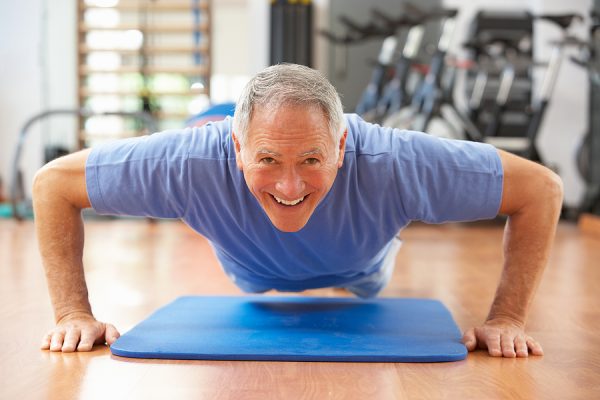By David Blyweiss, M.D., Advanced Natural Wellness
It’s amazing how confusing the concept of exercise can be. Ask five different fitness experts what you should be doing, and you’ll get five different answers.
“You should workout every day…”
“It’s okay if you only workout on the weekends…”
“It’s better to focus on aerobics…”
“It’s the strength training you should zero in on…”
“If you don’t work up a sweat, you’re not working hard enough…”
There is some truth to all of them. But grasping one single concept and sticking with it may do more harm than good. For example, while aerobics will help improve your aerobic capacity and lung strength, it does very little to improve bone and muscle mass.
Conversely, if you are only doing strength training, you are missing out on all of the cardiovascular benefits of aerobics that help keep your heart, lungs and brain healthy.
So it’s not about choosing one thing over another. It’s more about incorporating a combination of concepts that will give you the greatest return on your efforts.
Do You Have to Exercise Every Day?
The World Health Organization recommends 150–300 minutes of moderate intensity exercise or 75–150 minutes of vigorous intensity each week. But It’s important to note that they don’t say you have to spread it out over seven days.
In other words, if you can squeeze in an hour and a half of moderate intensity on Saturday, then another hour and a half on Sunday, you’ll still get the benefits.
People who get all of their exercise in one or two days a week lower their risk of premature death just as much as people who get the same amount of exercise over the course of a week. This includes death due to cardiovascular disease, cancer, diabetes, and other potentially fatal health conditions.
If you’re busy on Saturday or Sunday, just choose another day of the week to reach your goals. Do it not just for good health but for mortality.
This is really important, because according to America’s Health Rankings, only 23% of U.S. adults get the recommended amounts of activity each week. Worse, just about the same percentage of adults (22.4%) report getting no physical activity or exercise other than their regular job!
Worse, prevalence of physical inactivity is higher in people who are 65 or older, and these are the folks who need it the most!
Mix it Up for Better Health
I recommend a combination of aerobic and strength training. If you’re aiming for getting an hour and a half worth of exercise in one day, you can do it all at once or break it up over the course of the day. I also recommend adding an element of high intensity interval training, or HIIT.
For example, start your morning with a walk.
After warming up for a few minutes, begin by walking briskly for 30 – 40 seconds. Just walk as fast as you can. (You can even jog or sprint if your fitness level is up to it.) Then, slow down and spend three- or four-minutes walking regularly. Repeat four to six times.
In the mid-afternoon, you might get in some strengthening exercises with weightlifting. You can use either free weights or machines that use weights. If you are not familiar with using them, it’s extremely important to get some instruction first. A gym or fitness center usually has an in-house trainer who can familiarize you with the equipment to get you started.
Later in the day, some additional strength training might be in order. You can go the tried-and-true route of using your body weight for resistance by performing exercises like push-ups, squats and lunges. (If you’re unfit you could start off with wall push-ups, chair squats and supported lunges.)
Another option is to use resistance bands that are designed for exercise. You might hold one on the floor under your foot and pull it up with your arms. Or, if you lie down on your back, you can push on the bands with your feet while you hold them with your hands. There is a myriad of ways to use them and work out your entire body.
To maintain your health, your workouts don’t have to exceed the recommended guidelines. In fact, overdoing it on the exercise can damage muscles. This, in turn, produces inflammation and oxidative stress which are known factors when it comes to mitochondrial dysfunction. So don’t overdo it. And be sure to check with your doctor before starting a new exercise program.
By the way, if you don’t work up a sweat, don’t worry.
Sweat is not a judge of how hard you’re working. Rather, it’s temperature and humidity that will depend on whether you sweat or not. If you’re working out in a cool environment with low humidity you are less likely to sweat than when temperatures are in the 80’s or 90’s and humidity is high.
SOURCES:
Dos Santos M, Ferrari G, Lee DH, Rey-López JP, Aune D, Liao B, Huang W, Nie J, Wang Y, Giovannucci E, Rezende LFM. Association of the “Weekend Warrior” and Other Leisure-time Physical Activity Patterns With All-Cause and Cause-Specific Mortality: A Nationwide Cohort Study. JAMA Intern Med. 2022 Aug 1;182(8):840-848.
O’Donovan G, Lee IM, Hamer M, Stamatakis E. Association of “Weekend Warrior” and Other Leisure Time Physical Activity Patterns With Risks for All-Cause, Cardiovascular Disease, and Cancer Mortality. JAMA Intern Med. 2017 Mar 1;177(3):335-342.
America’s Health Rankings analysis of CDC. Behavioral Risk Factor Surveillance System. United Health Foundation. AmericasHealthRankings.org. Accessed 2022.



